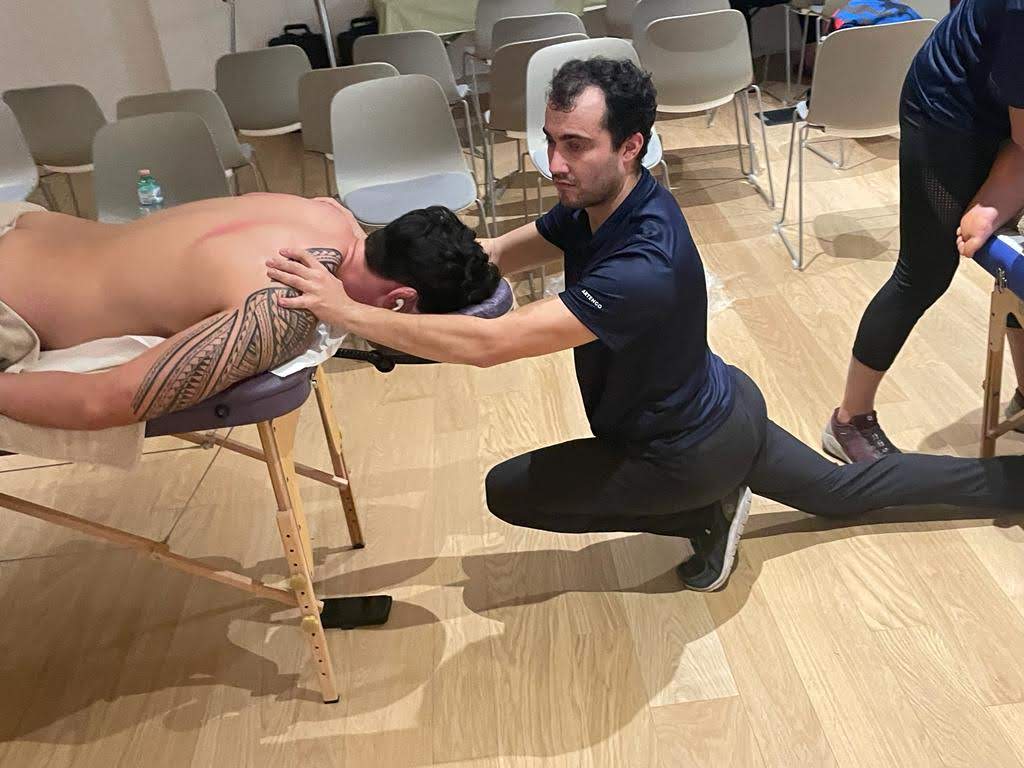
Shoulder is one of the most important and stressed joints during tennis practice activity. From the amateur tennis player, to the junior athlete to the professional, almost all players can tell you about a moment in their experience or career in which they had more or less severe problems or pain affecting this joint.
Although shoulder injuries are not the most common statistically, in fact ankle sprain is the most epidemiologically common injury, injuries to the upper limbs are those in which the problem is most often chronic and not acute (e.g. tear of the flexors of thigh).[1],[2]
Given the repetitive nature of the game, of the shots and the strong overhead component, the shoulder, fulcrum of contact between the upper limb that holds the racket and the trunk, is very stressed and technically imperfect movements can quite easily lead to problems with the tendons of the rotator cuff or subacromial impegment.
But how to evaluate a tennis player’s shoulder?
The first thing to keep in mind is the concept of kinetic chain. Each shot, especially complex ones like the serve, is the result of a sequence of muscular contractions and joint movements coordinated with each other, and the “break” at any point in the chain affects other elements, putting them at risk of injury. It is therefore of fundamental importance to evaluate the tennis player in his entirety, in fact it often happens that a joint limitation in the hip or a lack of muscle activation of a gluteus maximus lead to compensations such that it is the shoulder that suffers. [3][4]
Limiting ourselves to the strict evaluation of the shoulder however, the first evaluation is postural and static. We place the athlete standing in front of us and observe him. In professionals and junior elite athletes it is normal for the dominant shoulder to be in a forward and lowered position, this is the case for 82% of ATP professionals. Furthermore, atrophy of the infraspinatus muscle is also common[5].
A position that most highlights any asymmetries between the two shoulder girdles is that of “Hands on Hips”, in which the athlete places his hands above both iliac crests.
At this point we move on to evaluating active mobility, especially evaluating shoulder flexion and abduction on the scapular plane. During these movements, attention must be paid to the scapulothoracic joint and the movement of the scapula, looking for any dyskinetic movement, that means difficulties in activating the muscles that move the scapula when the humerus “rises” beyond 90 degrees of elevation. In stronger and elite athletes it is preferable to test it with 3/4kg weights in the hand, as they are stronger than normal population and dyskinetic movements are easily hidden and compensated without external loads. [6]
It is important to underline that dyskinesia is a symptom, but it’s not pathology, therefore presence of it does not necessarily mean that it is pathological, but in case of problems or pain of the athlete it must be taken into consideration in the evaluation.
Now we move on to the table where it is of fundamental importance to evaluate the passive, internal and external rotations.
Evaluation must be carried out with the athlete supine, stabilizing the scapula so that it does not compensate for the rotations that the operator is testing. The sum of the degrees of the rotations must be approximately 180 degrees, and it is normal for the tennis player to have the internal rotation of the dominant shoulder less than that of the non-dominant shoulder, provided that the total range is compensated by a greater external rotation and that between the limb dominant and non-dominant there is no more than 10 degrees of difference in total range of motion. [7]
If the internal rotation is too limited better restore the mobility promptly because with more than 10° missing athlete is at high risk of shoulder injuries.
On the table, the correct activation of the shoulder rotators can also be verified by isolating the movements we want to test and preferably measuring them with a dynamometer and not with the manual strength test, which is subjective and subject to operator-dependent errors.
The evaluation of the shoulder is completed not only by the global evaluation of the patient, but also by analyzing and testing the “rest of the body” of the athlete as already mentioned, with specific tests to evaluate the suffering of the supraspinatus tendon (Empty can, full Can and cheers test), subscapularis (Napoleon Test) or to evaluate a specific diagnostic suspicion (e.g. test for shoulder instability).
As always, respect for the team and one’s own professional limits is of fundamental importance, therefore referring the athlete to a trusted orthopedist if the tests reveal specific pathological conditions of the shoulder, in order to obtain a precise diagnosis which can also be obtained thanks to prescribed instrumental tests by the specialist.
Bibliography:
[1]Pluim BM, Staal JB, Windler GE, Jayanthi N. Tennis injuries: occurrence, aetiology, and prevention. Br J Sports Med. 2006 May;40(5):415-23. doi: 10.1136/bjsm.2005.023184. PMID: 16632572; PMCID: PMC2577485.
[2]Kerr ZY, Lynall RC, Roos KG, Dalton SL, Djoko A, Dompier TP. Descriptive Epidemiology of Non-Time-Loss Injuries in Collegiate and High School Student-Athletes. J Athl Train. 2017 May;52(5):446-456. doi: 10.4085/1062-6050-52.2.15. Epub 2017 Mar 30. PMID: 28358221; PMCID: PMC5455248.
[3]Lintner D, Noonan TJ, Kibler WB. Injury patterns and biomechanics of the athlete’s shoulder. Clin Sports Med. 2008 Oct;27(4):527-51. doi: 10.1016/j.csm.2008.07.007. PMID: 19064144.
[4]Sciascia A, Thigpen C, Namdari S, Baldwin K. Kinetic chain abnormalities in the athletic shoulder. Sports Med Arthrosc Rev. 2012 Mar;20(1):16-21. doi: 10.1097/JSA.0b013e31823a021f. PMID: 22311288.
[5]Ellenbecker TS. Chap 10 Muscoloskeletal screening for the elite and developing tennis player. In: Di Giacomo G, Ellenbecker T, Kibler WB, editors, Tennis Medicine Cham: Springer 2018
[6]Kibler WB, Uhl TL, Maddux JW, Brooks PV, Zeller B, McMullen J. Qualitative clinical evaluation of scapular dysfunction: a reliability study. J Shoulder Elbow Surg. 2002 Nov-Dec;11(6):550-6. doi: 10.1067/mse.2002.126766. PMID: 12469078.
[7]Ellenbecker TS, Roetert EP, Bailie DS, Davies GJ, Brown SW. Glenohumeral joint total rotation range of motion in elite tennis players and baseball pitchers. Med Sci Sports Exerc. 2002 Dec;34(12):2052-6. doi: 10.1097/00005768-200212000-00028. PMID: 12471315
